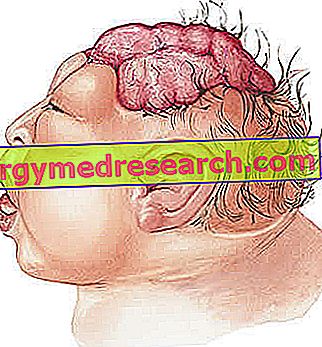Definition
In the medical field, petechiae identify small hyperpigmented punctate spots on the skin, formed as a result of the lack of certain coagulation elements; the cutaneous micro-macules have a smooth surface and a rather irregular shape, generally circular, whose color varies from the initial reddish-brown, to become yellowish and generally disappear after a few days. The petechiae, in themselves, do not refer to any medical urgency.
Causes
The petechiae are the most immediate expression of a rupture of the blood capillaries; petechiae formed around the eyes or on the face often result in an alteration in blood pressure, triggered by vomiting or a cough.
- Risk factors: platelet disorders (thrombocytopenia), oral antidiabetic agents, vitamin K deficiency, chemotherapy, circulation disorders, bacterial infections, skin aging, leukemia, infantile scurvy, Cushing's syndrome, trauma
Symptoms
The petechiae are not associated with any pain or discomfort: the signs are purely aesthetic. When the petechiae are numerous and arrange themselves to form a cluster of slightly larger macules, one speaks more correctly of purple, a typical symptom of some capillary alterations.
The information on the Petechiae - Medicines for the Care of Petechiae is not intended to replace the direct relationship between health professional and patient. Always consult your doctor and / or specialist before taking Petecchie - Medicament for Petechiae Care.
drugs
Although the presence of petechiae on the skin is not, in itself, a pathological condition, the opinion of the doctor is however recommended, since the spots on the skin can sometimes hide an underlying disease, much more serious. Just think, for example, of leukemia: petechiae are a characteristic symptom of the aforementioned cancer disease, in which there is an abnormal production of blood cells, unable to fulfill their role.
The treatment for petechiae depends on the triggering cause: we have seen that the thrombocytopenia can predispose the patient to petechiae, considering that the lack of platelets goes to alter the physiological mechanism of blood coagulation. According to this, restoring the standard values of thrombocytes (> 150, 000 units / m3) also favors the removal of petechiae from the skin.
Also the lack of vitamin C (scurvy) favors the appearance of petechial lesions on the skin: the integration of this very important vitamin is the first therapeutic measure to consider for the treatment of the disease (scurvy) with all its symptoms (including petechiae) ). The same is true for Cushing's syndrome: the clinical signs - petechiae, ecchymoses and purpura - that distinguish the disease can be removed only after undertaking a therapeutic procedure for the treatment of the syndrome.
There is no drug aimed at the mere cure of petechiae: as we have seen, these micro-spots on the skin are always the expression of a morbid condition or a vitamin deficiency, therefore the only way to remove the petechiae is the cure of the underlying disease.
Vitamin C supplementation: indicated for the treatment of petechiae in the context of scurvy. Scurvy is a disease derived from vitamin C deficiency, therefore the administration of ascorbic acid improves the patient's clinical picture.
- Vitamin C (eg Redoxon, Cebion, Cimille, Univit, C Tard, Agruvit, Univit, Duo C): indicatively, take 50-180 mg per day of vitamin C, orally, intramuscularly or intravenously. Do not exceed 180 mg of ascorbic acid per day.
For further information: read the article on drugs for the treatment of scurvy
Vitamin E supplementation
Some studies show that even the integration of vitamin E seems effective for the disappearance of petechiae.
- Vitamin E (eg Arovit, Evion, Ephynal, Rigentex, Sursum, E-Vitum): for the removal of petechia, it is recommended to take 400-600 mg of vitamin E daily, orally, according to the indications prescribed by the doctor.
Deepening: vitamin E intake seems to bring surprising results for the treatment of petechiae. According to what emerges from the studies of Dr. Fujii, vitamin E exerts an inhibitory action on the increase in the permeability of the capillary walls, derived from infective insults or from drug reactions
Reduction of cortisol production : in the context of Cushing's syndrome, the main goal is to reduce the overproduction of cortisol. Some drugs, such as Mitotano and ketoconazole, can reduce their synthesis and report improvements also on clinical evidence (in this case, petechiae).
For further information: read the article on drugs for the treatment of Cushing's syndrome
Cortisone therapy and administration of immunoglobulins : for the treatment of petechiae dependent on thrombocytopenia, therapy depends on the cause that arises at the origin.
For example, glucocorticoids tend to reduce bleeding (a symptom that distinguishes severe thrombocytopenia), while immunoglobulins are indicated for the treatment of thrombocytopenia dependent on an abnormal immune reaction. Sometimes, it is also possible to take immunosuppressive drugs, in order to reduce the administration of steroids.
Here are some examples:
- Dexamethasone (eg. Decadron, Soldesam): Dexamethasone, thanks to its anti-haemorrhagic effect, is indicated to block bleeding caused by thrombocytopenia. As an indication, take the drug at a dose of 40 mg / day for 4 days. Continue with 28 days of suspension and repeat the cycle, respecting the indications prescribed by the doctor.
- Cortisone (eg. Cortis Acet, Cortone): for the treatment of idiopathic (immune) thrombocytopenia, it is recommended to take 25-300 mg of drug a day, orally or intramuscularly, splitting the load in one or two doses.
- Gammaglobulins: immunoglobulins to be administered at high dosage (for severe forms of thrombocytopenia). The drug exerts its therapeutic activity by slowing down the platelet destruction process. For the dosage, consult your doctor.
For further information: read the article on the treatment of thrombocytopenia.
Chemotherapy therapy : last but not least, chemotherapy is indicated for the treatment of leukemia. As analyzed, leukemia can also promote the formation of petechiae on the skin; clearly, the speckles formed constitute a simple clinical evidence, but the underlying problem is clearly the neoplasm of the blood. The treatment of leukemia - therefore the restoration of blood composition within the normal range - also favors the removal of petechiae.
For further information: read the article on drugs for the treatment of leukemia



